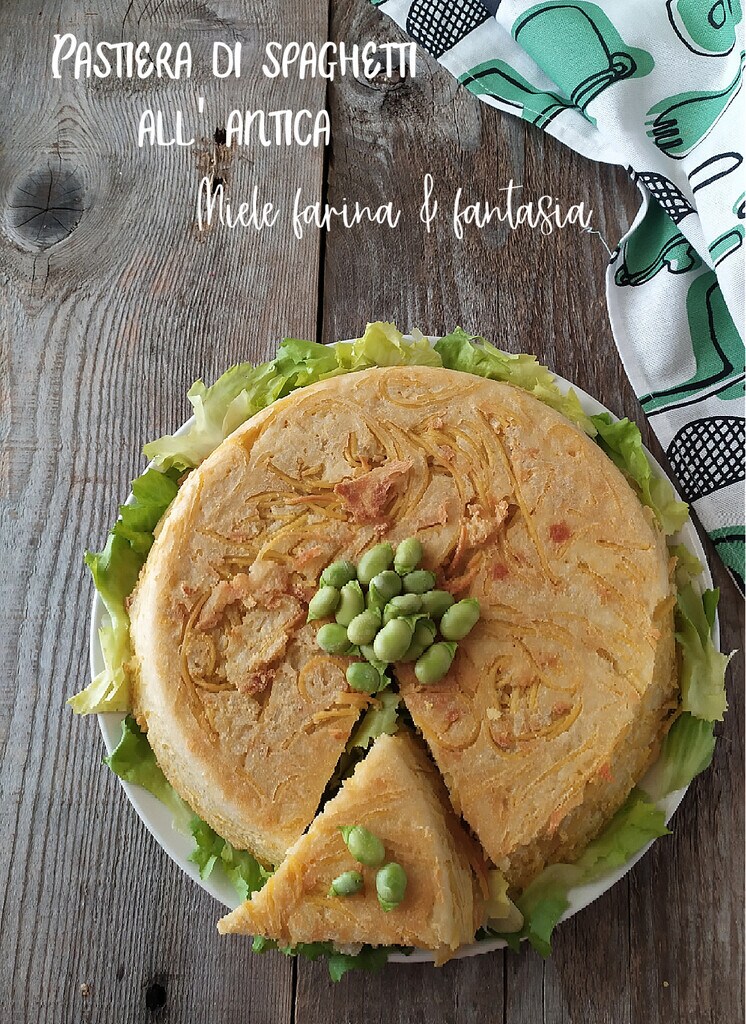Today I would like to talk to you about the old-fashioned spaghetti pie, a savory peasant dish from the tradition of the inland Caserta area, and specifically from the tradition of my mother-in-law’s family, to be eaten at lunch on Easter Eve, or among Easter appetizers and on Easter Monday. It is usually served with cured meats, cheeses, and fresh fava beans. Despite the name, it is a recipe that involves the use of spaghetti and rice together, accompanied by a filling of eggs, pepper, and cheese, to be cooked in the typical “ruoto” (that is, a flared round baking dish which is also the typical mold of the much more famous Neapolitan pastiera) in the heat of the wood or fireplace oven. The recipe I will present below is a family one, that is, as my mother-in-law’s family prepared it and, according to her, every family prepared it in their own way, with what they had available, making it more or less rich in ingredients. This preparation can also be made with gluten-free ingredients, using specific pasta in the mixture with rice, and suitable flours in the batter.
At the links below you will find, respectively, both gluten and lactose-free and traditional Easter recipes.

- Difficulty: Very Easy
- Cost: Economical
- Preparation time: 1 Hour
- Portions: 10
- Cooking methods: Stove, Oven
- Cuisine: Italian
- Seasonality: Easter Monday, Easter
Ingredients
- 9 oz spaghetti (also gluten-free)
- 9 oz Roma rice
- 5 whole medium eggs
- to taste ground black pepper
- 1 oz mix of grated Parmesan and Pecorino Romano
- to taste fine salt
- to taste lard or softened butter
- 5 tbsps all-purpose flour (or rice flour)
- to taste water
- 2 tbsps grated Pecorino Romano
- to taste grated pepper
- 1 pinch Fine salt
Tools
- 1 Aluminum Baking Dish
Steps
To prepare our old-fashioned spaghetti pie, we heat the water to cook the pasta. When the water boils, we weigh the spaghetti, break them in half and put them in the water.
Cook them for the time stated on the package and no longer, in already salted water.
In the meantime, cook the rice in salted water, for the time stated on the package.
In this way, both the pasta and the rice will have more or less the same consistency and we will not be forced to add too many eggs to have a mixture that is soft and well blended, which is not dry.
Transfer the perfectly drained pasta and rice into a bowl.
Add the slightly beaten eggs, plenty of grated cheese, an equally generous grind of pepper and mix well. Set it aside for now
Preheat the oven to 392°F
For the mold (after preparing the pasta and rice mixture): generally, for these amounts, a flared round “Neapolitan pastiera” aluminum mold of about 9.5-10 inches is used, for a spaghetti pie three fingers thick, or larger for a thinner pie.
-Grease the mold with a little lard or softened butter (you can also use seed or olive oil).
Prepare the batter.
Mix the flour with some water to form a soft batter that is not too liquid but not too dense and hard either. Add the fine salt, grated cheese, a pinch of pepper, and mix the ingredients.
Pour half of the batter on the bottom of the greased mold, add the pasta and rice mixture, and level it well with the back of a spoon.
Finally, cover it with the remaining batter, trying to distribute it evenly, and also add a bit more lard or a few dots of very soft butter here and there (the purpose of covering the rice and pasta mixture with the batter, also adding lard or butter is to prevent the pasta from curling and becoming dry, hard, or even burnt during cooking; same for the rice).
Bake the spaghetti pie immediately at 392°F at mid-height. Cook it for about 20 minutes or until it becomes golden (it should not color too much), both on the bottom and on the surface; being careful not to let it become too dark as it would then be excessively dry.
We can eat it hot or cold, alone or accompanied by cured meats and it will be even better the next day.
Gluten-free version
To make this delight gluten-free, use specially formulated spaghetti; for the batter, I recommend using a bread mix, a universal mix, or a thickener like psyllium, otherwise, it won’t be possible to make one.
Furthermore, it may be necessary to add one more egg to the pasta and rice mixture compared to the gluten version. The procedure remains the same in both cases.
Bon appetit

